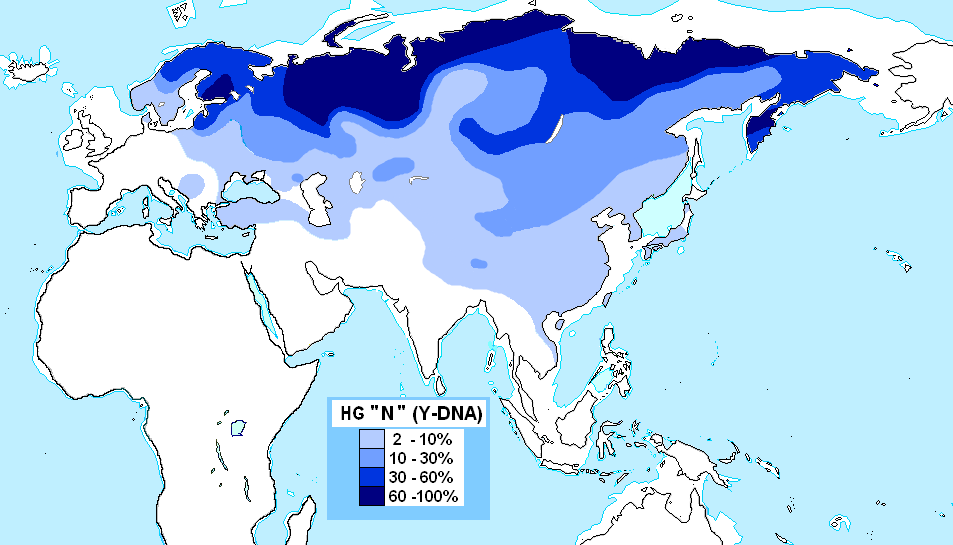|
|
Post by Διαμονδ on Nov 14, 2017 17:26:50 GMT
Haplogroup N (M231) is a Y-chromosome DNA haplogroup typical of Northern Eurasia, which is defined by the presence of the marker M231 Origins Haplogroup N-M231 is a descendant haplogroup of Haplogroup NO1-M214. Its most recent common ancestor with its nearest outgroup, haplogroup O-M175, is estimated to have lived about 36,800 or 41,900 years ago. However, extant haplogroup N-M231 is considered to be relatively young, having populated the north of Eurasia after the last Ice Age. Males carrying the marker apparently moved northwards as the climate warmed in the Holocene. It is suggested that N-M231 arose in Southeast Asia 19.4±4.8 ky years ago, and then migrated in a counter-clockwise path from modern day regions of Mongolia and northern China to as far as northeastern Europe (Rootsi 2006). The absence of haplogroup N-M231 in the Americas indicates that its spread across Asia happened after the submergence of Beringia (Chiaroni 2009). Possible time of origin 36,800 [95% CI 34,300–39,300] years before present 41,900 [95% CI 31,294–51,202] years ago Possible place of origin East Asia Coalescence age 22,100 [95% CI 19,800–24,400] 19,153 [95% CI 13,677–24,422] years ago about 21,000 years ago Ancestor Haplogroup NO Defining mutations M231  Estimated prehistoric migration routes for Y-chromosome haplogroup N lineage.  |
|
|
|
Post by Διαμονδ on Nov 14, 2017 17:37:22 GMT
Distribution
Projected distributions of haplogroup N sub-haplogroups. (A) N*-M231, (B) N1*-LLY22g, (C) N1a-M128, (D) N1b-P43, (E) N1c-M46.
Haplogroup N has a wide geographic distribution throughout northern Eurasia, and it also has been observed occasionally in other areas, including Southeast Asia, the Pacific, Southwest Asia and Southern Europe.
Its highest frequency occurs among the Finnic and Baltic peoples of northern Europe, the Ob-Ugric and Northern Samoyedic peoples of western Siberia, and the Siberian Turkic-speaking Yakuts (McDonald 2005).
|
|
|
|
Post by Διαμονδ on Nov 15, 2017 8:36:07 GMT
Haplogroup N1a1 determined mutations M46/Tat and P105. The number of carriers of this subclade several times higher than the rest of haplogroup N. This haplogroup is found in Central and Northern Europe, and throughout the European and Asian parts of Russia. The predominant carriers of this haplogroup are the Finns (68 %), Balts (41 %), Yakuts (80 %) Udmurts (56 %), the Eastern Buryats (71,9%) the Tatars (22.6%) of. It is assumed that N1a1 arose 10 600 — 12 700 years ago on the territory of modern Northern China, and later spread to Siberia to the Urals, where in the next few millennia appeared and spread Uralic languages. The second wave of expansion of haplogroup N1a — from the Urals into North-East Europe, apparently, was connected with the spread in this region of the ancient Finno-Ugric languages. Subclade N1a1-L1025 was formed in the South-Eastern part of the Baltic sea about 3000 years ago, now its representatives are almost completely from Baltic country. Among Siberians, haplogroup N1a1 discovered in Yakuts (80 %). The diversity N1a1 them is small, which may indicate the passage of the population through the bottleneck or the founder effect. This haplogroup was also detected in 2.4% of Koreans in Seoul and in 1.4% of the Japanese Prefecture Tokushima Prefecture, 13, 13, and 29% Russian Slavic groups Kursk, Tver and Arkhangelsk regions, respectively. Belarusians frequency of haplogroup N1c is from 8% in the South to 15% in the North!  |
|